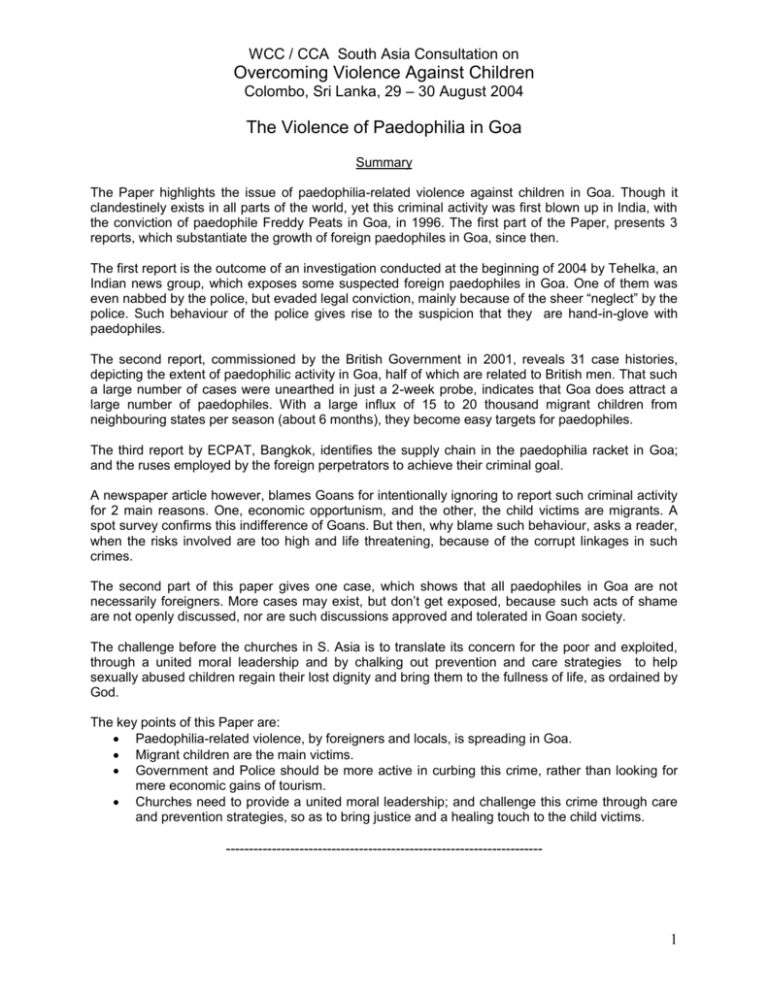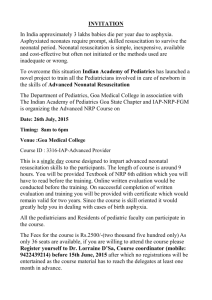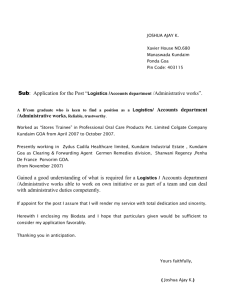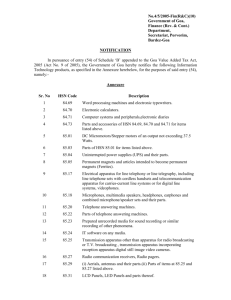Child Sexual Abuse / Paedophilia
advertisement

WCC / CCA South Asia Consultation on Overcoming Violence Against Children Colombo, Sri Lanka, 29 – 30 August 2004 The Violence of Paedophilia in Goa Summary The Paper highlights the issue of paedophilia-related violence against children in Goa. Though it clandestinely exists in all parts of the world, yet this criminal activity was first blown up in India, with the conviction of paedophile Freddy Peats in Goa, in 1996. The first part of the Paper, presents 3 reports, which substantiate the growth of foreign paedophiles in Goa, since then. The first report is the outcome of an investigation conducted at the beginning of 2004 by Tehelka, an Indian news group, which exposes some suspected foreign paedophiles in Goa. One of them was even nabbed by the police, but evaded legal conviction, mainly because of the sheer “neglect” by the police. Such behaviour of the police gives rise to the suspicion that they are hand-in-glove with paedophiles. The second report, commissioned by the British Government in 2001, reveals 31 case histories, depicting the extent of paedophilic activity in Goa, half of which are related to British men. That such a large number of cases were unearthed in just a 2-week probe, indicates that Goa does attract a large number of paedophiles. With a large influx of 15 to 20 thousand migrant children from neighbouring states per season (about 6 months), they become easy targets for paedophiles. The third report by ECPAT, Bangkok, identifies the supply chain in the paedophilia racket in Goa; and the ruses employed by the foreign perpetrators to achieve their criminal goal. A newspaper article however, blames Goans for intentionally ignoring to report such criminal activity for 2 main reasons. One, economic opportunism, and the other, the child victims are migrants. A spot survey confirms this indifference of Goans. But then, why blame such behaviour, asks a reader, when the risks involved are too high and life threatening, because of the corrupt linkages in such crimes. The second part of this paper gives one case, which shows that all paedophiles in Goa are not necessarily foreigners. More cases may exist, but don’t get exposed, because such acts of shame are not openly discussed, nor are such discussions approved and tolerated in Goan society. The challenge before the churches in S. Asia is to translate its concern for the poor and exploited, through a united moral leadership and by chalking out prevention and care strategies to help sexually abused children regain their lost dignity and bring them to the fullness of life, as ordained by God. The key points of this Paper are: Paedophilia-related violence, by foreigners and locals, is spreading in Goa. Migrant children are the main victims. Government and Police should be more active in curbing this crime, rather than looking for mere economic gains of tourism. Churches need to provide a united moral leadership; and challenge this crime through care and prevention strategies, so as to bring justice and a healing touch to the child victims. --------------------------------------------------------------------- 1 WCC / CCA South Asia Consultation on Overcoming Violence Against Children Colombo, Sri Lanka, 29 – 30 August 2004 Paper on The Violence of Paedophilia in Goa (This Paper geographically limits itself to Goa, on the issue of violence against children committed through Paedophilia) It was Rabindranath Tagore who once said that every time a child is born, it brings with it a hope, that God is not displeased with human beings. However, if we take a look at the violence committed against millions of children in the world, would God still be pleased today? Everyday without fail, newspapers carry reports about children being raped by a father, a relative or a neighbour. Girl children work as “guest relations officers”, a euphemism for sex entertainers in disco joints and beer parlours. Today, there exists a “Kids Porn” website, where children and not adults are chosen for sexual gratification. Over the years, there has been an increase in the number of children who are trafficked and pushed into the flesh trade. Again, the figures of child sexual exploitation vary. According to UNICEF, out of an estimated number of 4 lakh sex workers in India, some 30% are below 16 years of age. However, according to End Child Prostitution And Trafficking (ECPAT) International, it is estimated that there are 9 million sex workers in India, and some 30%, i.e. 2.7 million are children. Article 19 of the UN Convention on the Rights of the Child sets out the child’s right to protection from violence, stating that: States Parties shall take all appropriate legislative, administrative, social and educational measures to protect the child from all forms of physical or mental violence, injury or abuse, neglect or negligent treatment, maltreatment or exploitation, including sexual abuse, while in the care of parent(s), legal guardian(s) or any other person who has care of the child. In the final analysis, such violence is not merely a matter of moral degradation, but has to be viewed as a manifestation of the abuse of power – economic power, socio-political power and sometimes even religious power. Part I. Paedophilia – Sin in Paradise – Goa. Paedophilia is not exclusively a Goan problem. It exists across the country and across the world – and not just in tourist destinations. What is important to understand is that more than being a crime, it is a mental disorder, which drives certain adults, regardless of their nationality, race, sex and social background, to sexually abuse children. Goa is a tourist destination. It also attracts children from the poverty-stricken neighbouring states. Goans are familiar with the cruelty of paedophilia. They have long woken up to this vicious racket set up and run by foreigners for their individual or their community’s pleasure. The Freddy Peats case of 1996 is still fresh in the mind of Goans. He ran an “orphanage” for 19 Goan boys of broken families and alcoholic parents. Government agencies tried to sweep the case under the carpet. Among those who conspired to deny justice to the juvenile victims and even attempted to destroy documents and evidence, were the State Advocate General and Trial Judge. It was only through the dogged tenacity of a noted jurist, Adv. Sheela Barse, which finally got Peats convicted and jailed for life. After almost a decade, the racket has now gone commercial and highly organised, with international criminal networks entering it. The following 3 recent exposés highlight the horror of violence against children in Goa, with the growth of paedophilia. 2 1. The Tehelka Investigation. A five-month undercover investigation conducted at the beginning of 2004 by Tehelka, an Indian agency, revealed that hundreds of Europeans — British, Germans, Dutch, French, Swiss and Swedish — visit Goa to seek children for sexual gratification. They come to Goa because it is easy and cheap, to sexually abuse a child here. On the run after crackdowns on child-sex tourism in Thailand and Sri Lanka, the paedophile bus has now rolled into Goa; and turned the picture-postcard tourism destination into a paedophile’s paradise. Goa beckons paedophiles, who travel in order to sexually abuse children because such crimes are tolerated in India and hardly ever lead to conviction. The latest government statistics show that 3,21,399 foreign tourists visited Goa between April 2003 to March 2004, of which 1,20,653 were Europeans. The state earned Rs. 3,000 crores in foreign exchange. European paedophiles have virtually kick-started a cottage industry of child sex abuse in Goa wherein poor parents, an uncaring society, a callous bureaucracy, a corrupt police and an insensitive government look the other way, to facilitate the sexual exploitation of children. The Goa Police admitted the problem of paedophilia in the state, but denies that the magnitude of the problem is as large as depicted by the media. It says that paedophilia is not yet a threat to Goan society. The Deputy Inspector General of Police (Range), Mr Narender Singh Randhawa, admitted that the Goa Police had prior information about the two foreigners – Jorge Harry Ringlemann (German) and Dreyfuss Bernard Jean Paul (French) – who were named in the television programme. He was responding to the Tehelka story “The Nexus of Silence” screened by a private television channel on August 5, 2004 about paedophilia in Goa. Ringlemann, the German national and an alleged suspect in paedophilia cases and wanted by the Goa police, was finally nabbed, only after the TV story. He was deported because he was an "undesirable element" with incomplete documentation to support his claims to both the minor girls he was living with. The police also say that the German national was not arrested, as there was no complaint registered against him by any one. To add salt to the wound, the government thinks that Tehelka's exposé appears to be an "advertisement campaign" for attracting paedophile clientele to Goa, rather than exposing their heinous criminal activity. Yes, it does seem like an open invitation for more paedophiles to come to Goa, do their thing and then leave. No arrest. No jail. No punishment. No problems at all. The very fact that Ringelmann was deported means he was not charged here for paedophilia. This, despite the admission that the police had received information in April 2003 that "Some foreign national by the name of Ringelmann Jorge Harry, German national, holder of passport No.5041803573, is suspected to be involved in paedophile activities." And about the other paedophile mentioned in the Tehelka story, Dreyfuss Bernard Jean Paul, the police just say, “He has left the country”. The French national had arrived in India in October 2003 and had stayed in a flat in Goa for about a month; and reportedly left Goa in December 2003. He was seen moving around with a boy during his stay. The police, despite making all efforts, also say they could not locate the minor boy, In another case profiled in the Tehelka exposé, the police raided the house of suspected paedophile, Theodore Wilhem Anema, who was traveling with two children. He was allowed to go, following his disclosure that his "adoption deed" had been registered with the Directorate of Women and Child Welfare. Why hadn't the Directorate verified Theo's antecedents? Why wasn't the "adoption deed" scrutinized, when the law unambiguously states that for any adoption to be legal, there must be a court order signed by the magistrate? Another paedophile figured by Tehelka, David Meredith Vagg, shut out the world from his life for an entire week. He did not step out of his house and took no phone calls. This elderly British national and a long running paedophile suspect, was just hoping that the storm would pass by. Vagg is clearly shown as a suspected paedophile in a Goa police document, which is in Tehelka’s possession. 3 But Goans were not doing enough to report such crimes, cries out an editorial article in the press, captioned "Unpleasant Face of Goa's Tourism Sector”. The article revealed that foreign paedophiles were reportedly running a ‘shelter house’, which was mentioned in the Tehelka story. Many migrant children were reportedly seen at this house. The paedophiles spread the news in the village, that they were doing evangelisation work and the children would soon be given mass baptism. The whole village was excited. Nobody tried to find out the antecedents of the foreigners who were running the “godly“ business. Nobody thought about the necessary legal consent required from the parents or guardians of the children, for any such conversion, leave alone “mass conversions”. If the local people were a little more curious, perhaps they could have tipped off the higher-ups in the police and the government. However, the article concludes, the smokescreen of charity and the children being migrants, as well as the economic opportunism of the villagers, blinded the locals into a syndrome of social apathy. To a question in a newspaper survey, whether Goan society was indifferent to the issue of paedophilia, 62% replied yes, while only 30% replied negatively. The others did not know. However, in response to the problem of social apathy, the following reply appeared in the press. “We want to tell why people are not reporting to the police or other authorities. If one is stupid enough to do so, the police will tell your name to the offender. This is because the police are, most often, hand in glove with the offenders and well taken care off by them. On the other hand, one is likely to lose his life or get beaten up by the goons of the offenders. We say, give us a minister, a police officer who is not on the pay roll of the criminal gangs in Goa and we shall fill your police station diaries with names of the drug cartel leaders, the prostitution-running agencies, the 5 star hotels which are the holes for prostitution and blackmail, the paedophiles, the smugglers, the murderers who are still at large, the liquor adulterers, the whole lot. People don't want to do the job of the government and the law enforcing agencies, when these are absolutely linked with the bad guys. People, as it is, are hard-pressed to earn their living.” Again, in an attempt to undermine the exposé, Goa’s Chief Minister (CM) claimed that the Tehelka portrayal had been carried out at the behest of a rival tourist destination, seeking to divert Goa's tourist traffic towards its shores. The CM also argued that since Tehelka could list only a few tourism-related paedophilia cases in its five-month-long investigation, it proved that the issue was not grave in the state. After spinning such face-saving tales, the CM cautiously began a process of backtracking on his offthe-cuff reactions. Among the first measures that the government announced was a decision to ask the Central government to put in place, a system whereby police authorities can track the arrivals of suspected paedophiles in India. Earlier, in his immediate reaction to the exposé, he had admitted the government's inability to keep a proper tab on foreigners entering the state from other states. He spoke about the need for an interlinking of passport checking systems at airports all over the country, for easy verification of the antecedents of visiting foreigners. He also said that children living with foreigners would be taken away from them and sheltered in Bal Niketan, a children's home run by the state government. But the government has not announced a follow-up plan. Will these children be looked after by the state? Who will fund their education and livelihood expenses? So much for his spirited statements earlier, claiming there was no evidence of organised and widespread paedophilia in the state. The CM instructed the Directorate of Women and Child Welfare to compile a comprehensive list of orphanages and shelter homes; clearly implying that the department did not have such a list in its possession. He also announced a deadline for setting up a Children's Court to try crimes registered under the Goa Children's Act, 2003. Finally, the CM admitted that the police force in Goa needed to be sensitised to deal with child abuse. According to him, so far policemen have been insensitive in dealing with such crimes. Besides, he also said that local communities should be sensitive to paedophilia cases and report instances of child abuse to the police. 4 The Archdiocese of Goa decided to screen the Tehelka film in all its 156 parishes throughout the state, starting with coastal Goa first. Fr. Valeriano Vaz, director of Caritas, chalked out a plan of action that involved energising the social action groups of each parish church, by first screening the film and then holding a discussion on the issue of tourism-related paedophilia. This church initiative hoped to mobilise the local people to help the local authorities to crack down on sex abuse of children by visiting foreigners. 2. The British Government Report. In 2001, the UK government commissioned a top-notch former police investigator, Ric Wood, to map the extent of tourism-related paedophilia in Goa. Over a two-week period, Wood compiled 37 case histories. Nearly half of these cases related to British men. The confidential Report revealed that tourism-related paedophilia is moving out of Thailand and looking for more vulnerable targets on the beaches of Goa and Kerala. It also said that the children in these destinations were particularly vulnerable, because they often became victims, in connivance with their own parents. The Report stated that it is virtually impossible to quantify how many paedophiles visit Goa every year. Also, the sheer number of cases that were unearthed in just a two-week probe revealed that Goa attracts a high preferential of paedophilia traffic. This meant that pederasts travel to Goa for the specific purpose of exploiting children sexually. According to Wood, the paedophiles, especially British paedophiles, targeted boys "between the ages of 8 and 13." The Report went on to reveal, "It is apparent that there are large numbers of children entering Goa from other states. Numbers vary, but the tourist industry generally agreed that there were between 15,000 and 20,000 children in the season (October to March of the next year). A sizable proportion of this group consisted of children under the age of 14. They were easy targets for paedophiles, since the children were emotionally needy and materially deprived." The then Director of Tourism estimated that 40,000 migrant children were vulnerable to sexual exploitation. Similarly, the Superintendent of Police also revealed that the police knew that pederasts exploited migrant children. Wood's investigation revealed an interesting trafficking dimension to Goa's sex tourism. He says, "Disturbingly, there is a huge increase in the amount of young girls traveling into Goa from Andhra Pradesh (AP). There are two trains per week arriving in Vasco (Goa's main railhead) from AP. At the beginning of the tourist season, there are approximately 50 girls (aged between 13 and 17), arriving on these trains each week". He further reported, "A growing number of paedophiles have discovered Goa to be a safe haven. They form part of a wider syndicate operating globally, within a well defined network, operating with the use of modern communication systems like the Internet," In response to the Report, the British Deputy High Commissioner, Howard Parkinson, reiterated that Goa was becoming a destination for British paedophiles. “Paedophilia is a highly emotive issue in Britain, and we would do anything to help you catch a British paedophile and keep tourism here clean”, the diplomat said. British authorities said they were keen to fund training and the transfer of expertise in curbing child sex abuse, to the police and tourism services in Goa. 3. The ECPAT Report The report “A Situational Analysis of Child Sex Tourism in India (Kerala & Goa)” conducted by EQUATIONS, Bangalore; and commissioned by End Child Prostitution and Trafficking (ECPAT), Bangkok, admitted that hardened paedophiles were in touch with people in Goa, who were known to supply children for the right price. The report identified beach boys, shack owners, taxi drivers and motorcycle pilots, as known suppliers. The parents were aware, said the report, that their children were being abused, but the lure of money and gifts was too strong. 5 Posing as rich philanthropists, the report said, some paedophiles boldly approached local NGOs and orphanages, and volunteered their services and offered money to them. Some had even gone to the extent of attempting to set up “shelters” for children. One reason for the rise of paedophilia in Goa was that mostly it was the “outside” (migrant) children who were the victims. Though few will admit it, NGOs find that Goans, including members of village panchayats, were unconcerned by this fact, concluded the report. But Goans are fooling themselves, if they think that paedophilia is a “foreign” or “outsider” issue only. The following part of this paper exposes the case of a Goan paedophile. It is felt that this case may be just one of the many others that exist in Goan society. They remain undisclosed, because, just like the proverbial monkey, Goans would like to see no evil, hear no evil; and much less, talk about it, especially paedophilia. Part II. Paedophilia - The Sin Among Goans "The state shall ensure that the children and the young are protected against exploitation and that they are given opportunities and facilities to develop in a healthy manner and in conditions of freedom and dignity. Childhood and youth shall be protected against exploitation and against moral and material abandonment." - Goa Children's Act, 2003, For many years, Goans were led to believe that paedophilia was a practice indulged only by some perverted foreign tourists. After the notorious Freddy Peats case, which could happen in front of an unsuspecting Goan neighbourhood, this belief was further strengthened. Goan paedophiles must have had a good laugh. They could get away with their horrendous crime, because public attention and even the post-Peats activism, was concentrated on foreign paedophiles. That was at least till 2003, when a Goan “Peats” was suddenly discovered and nabbed. The Mapusa Racket. The social lid over moral decay in Goa was finally blown up by the exposure of the paedophilic ring in the city of Mapusa. This particular case seems to have involved mostly poverty-stricken non-Goan children totally vulnerable to abuse. Even then, the evidence so far presented to the police showed a far sinister design. What has been revealed so far does not give a character certificate to the Goan society. The fact that some perverted Goans are involved in this case shows that elsewhere in Goa, such cases might have gone undetected because Goans strongly believe that if they looked the other way the evil would automatically disappear. Avelino Pinto and Francis Fernandes were arrested between 10th and 11th October 2003 and were remanded to police custody. The police registered complaints of sexual assault/rape of four minors against Pinto. A bail application moved by Pinto was rejected. From reports, it is believed that a minimum of 20 to 30 children have been abused by Pinto. Mr. Avelino Pinto first came under scrutiny of a woman’s group when he approached it for assistance for children who had been raped and who, he claimed, he had adopted. The group was surprised to know that these were children of the same woman who had earlier approached it for assistance, as her husband was an alcoholic. Mr. Pinto had made the husband execute an affidavit to the effect that he was handing over the children to Mr. Pinto for adoption, though this was no legal adoption document. What unraveled was a saga of abuse, trauma, deceit and extortion by Mr. Pinto. The woman’s group got the children removed to safer places. The children were not in a position to file a police complaint due to the then prevailing circumstances. It is situations like these that made Mr. Pinto bolder in his operations. Earlier, Mr. Pinto used to approach several organisations and pose as a social worker, in order to build good will and indirectly insure himself against suspicion. He claimed to be an engineer and sometimes a lawyer. In one such exercise, Mr. Pinto approached the woman’s group stating that one Mr. Francis, the owner of a liquor bar at Mapusa, was abusing a minor girl. Investigations led the 6 group to the minor, who then confided her story of abuse, both by Mr. Avelino Pinto and Mr. Francis Fernandes. Both were later arrested. The Mapusa case, on preliminary analysis, showed that there was a degree of social sanctity or tolerance, despite knowledge of the people familiar with the routine of the suspects. Perhaps the people must have thought that non-Goan child victims have no dignity. Perhaps things would have been different if Goan kids were to be molested. But paedophiles do not distinguish between victims. They are sexual predators. They are smart and take utmost care to hide their tracks. Domestically bred Goan paedophiles maintain a low profile. In a liberal Goan society it is difficult to suspect that a familiar local personality, stripped of the social mask, could be actually a weird and sexually perverted person. Paedophilia does not depend on nationality or relationship. Incestuous paedophilia in Goan families is common, but they prefer to keep a tight lid over it, because talking about it is a shame. Innocent children have thus become easily accessible sexual toys in the hands of paedophiles in the family. Non-incestuous paedophiles most often exploit the socio-economic weaknesses of the parents of their victims. The number of sexually traumatised children by Goan paedophiles may be many, but there is no way to know, because such acts of shame are not openly discussed, nor are such discussions approved and tolerated by Goan society. Conclusion In this age of dominant economic globalisation and free market forces, children are becoming commodities, and just like any commodity, they are bought, used, and later thrown out, when no longer needed. Societies, which compromise morality for short-term economic gains, ultimately succumb to anarchy and violence. Children will be the worst sufferers, because they are the most vulnerable in society. The fullness of their lives will be snuffed out. It is time for the churches in S. Asia to step beyond sporadic and fragmented efforts while addressing the scourge of violence against children. Child trafficking syndicates operating globally, within a highly organised network, with the use of modern communication systems like the Internet, requires an equally organised and sustained response from the churches. They need to bind themselves together with resolve and strategy, and with the grace of God, in order to turn the tide of this growing epidemic that is ravaging our countries. Churches are the single largest resource, which could play an effective role to eliminate violence against children. The churches are present in every country and have a mandate to protect and advocate for the abused children. Accordingly, some of the recommendations for this South Asia Consultation “Overcoming Violence Against Children” being held in Colombo, Sri Lanka in August 2004, is to evolve strategies that unite, inform, equip and mobilize churches to: a) Address the problem of violence against children, and at the same time, b) Care for the abused children, so as to help them regain their lost dignity; and bring them to the fullness of life, as ordained by God. Reggie Gomes, Convenor, Forum for Child Rights (FCR), National Council of Churches in India / Urban Rural Mission (NCCI / URM) 7



